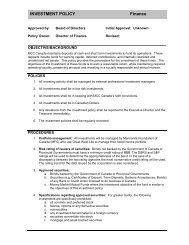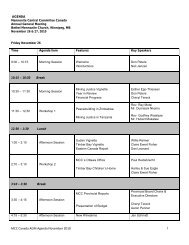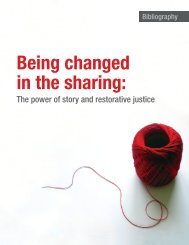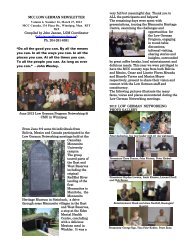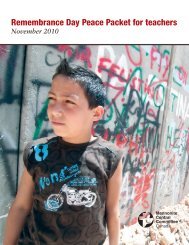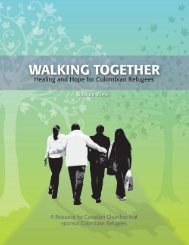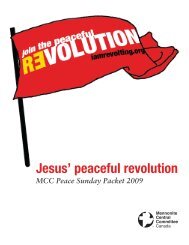to download PDF - Mennonite Central Committee Canada
to download PDF - Mennonite Central Committee Canada
to download PDF - Mennonite Central Committee Canada
Create successful ePaper yourself
Turn your PDF publications into a flip-book with our unique Google optimized e-Paper software.
On becoming a COHow does one learn about peace and resistance <strong>to</strong> war? Inoral accounts of Canadian World War II conscientious objec<strong>to</strong>rssome of the men illustrate how they came <strong>to</strong> their peaceposition. One gets a sense that the CO stance arose out of atheology of non-resistance which was not always clearlyarticulated, but often simply assumed.Harold Schmidt experienced the church as a sustaining forcein his hard growing-up years on the farm and felt that thevalues were strongly emphasized. His alternative serviceexperience included having <strong>to</strong> answer letters of protest frompeople who were upset at the COs; this opposition helpedhim <strong>to</strong> crystallize some of his own beliefs. Peter Neufeldrecalls a specific sermon that shaped his thinking, using theexample of Shadrach, Mishach and Abednego. Others felt ithadn’t been necessary for them <strong>to</strong> think through their ownconvictions because the church had negotiated collectively forCO status. Becoming a CO was simply accepted as the thing<strong>to</strong> do; they had chosen alternative service because of theconviction of others.Clay<strong>to</strong>n Burkholder felt a strong family influence <strong>to</strong>wardsnon-violence, but recognizes there was also a lot of pressurefrom the church. Once the option of conscientious objectionhad been negotiated for the <strong>Mennonite</strong> “boys,” <strong>to</strong> choose anyother option was <strong>to</strong> say no <strong>to</strong> church membership. As OldOrder Amish, David Jantzi says he would have been excommunicatedif he hadn’t taken the CO option.Many of these s<strong>to</strong>ries have been captured on tape and arepreserved at the <strong>Mennonite</strong> Archives of Ontario. For moreinformation, contact Sam Steiner steiner@uwaterloo.ca.Getting on the right trainI grew up in the <strong>Mennonite</strong> church, but I don’t rememberhearing much about being a pacifist, or having a peace position.It was only when I went <strong>to</strong> college that I learned moreabout his<strong>to</strong>ric peace churches and conscientious objection.Will we remember?The epicentre of the earthquake that causedthe 2004 tsunami was 40 miles from the islandof Simeule, Indonesia. This was the first coastline<strong>to</strong> feel the affects of the massive 33-footwaves that smacked ashore. Reporters founddevastation just like in other places, but therewas something different. The island lost only 7of it 75,000 inhabitants. Why so few? Whenthe islanders were interviewed and asked aboutthis they <strong>to</strong>ld the reporters that in 1907 therehad been another earthquake. The groundshook and the water moved out but came backwith a vengeance and killed many people. Thisexperience was <strong>to</strong>ld and re<strong>to</strong>ld from one generation<strong>to</strong> another. For almost 100 years thepeople kept this s<strong>to</strong>ry alive, telling the nextgeneration that when the earth shakes and thewater moves out they should head <strong>to</strong> higherground. On December 26, 2004 the people ofSimeule moved <strong>to</strong> higher ground. When theearth shook and the water moved out, theyknew what <strong>to</strong> do—because they remembered.So my question <strong>to</strong>day is: when the earthshakes and the water moves out for you, whats<strong>to</strong>ries do you hold on <strong>to</strong>? What about foryour children or grandchildren? What s<strong>to</strong>riesand wisdom will be remembered? The s<strong>to</strong>ry of<strong>Canada</strong>’s conscientious objec<strong>to</strong>rs is one thatcan provide examples and can encourage us <strong>to</strong>find ways of staying true <strong>to</strong> our beliefs.—Conrad S<strong>to</strong>esz,<strong>Mennonite</strong> Heritage Centre, WinnipegI came home from college one summer wondering about the picture in our family album ofmy father in a Canadian military uniform. My uncle <strong>to</strong>ld me the s<strong>to</strong>ry of how my dad hadinitially decided <strong>to</strong> be a conscientious objec<strong>to</strong>r by doing alternative service in a lumbercamp. On his way <strong>to</strong> the camp, the train he was on s<strong>to</strong>pped at a little <strong>to</strong>wn. A traincoming back from the north also happened <strong>to</strong> s<strong>to</strong>p there. He heard s<strong>to</strong>ries from the menon the other train about how hard life was in the lumber camps. He jumped off one train,got on the other and promptly enlisted in the army.I have my own children now. I try <strong>to</strong> teach them what I believe: carrying the peace of Jesuscannot be combined with carrying a weapon. I wish our churches spoke more openlyabout the his<strong>to</strong>ry of our struggle with violence. I want my children, when the time comes,<strong>to</strong> be absolutely clear about which train they will take. —Carol Penner, Vineland, Ont.S<strong>to</strong>ries and reflections8



